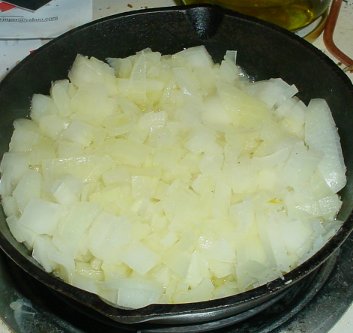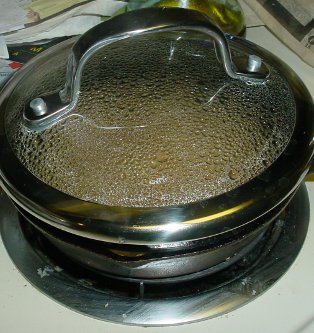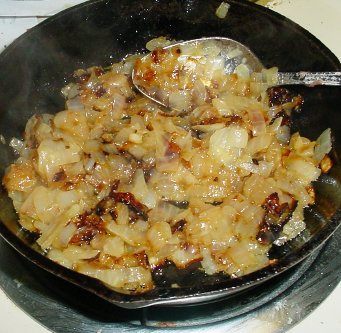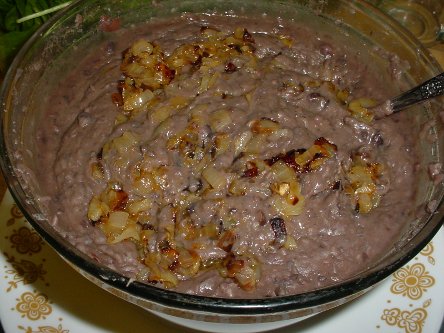I first became aware
of what a great deal cooking your own beans was when Cathy Deppe sold
me a packet of Women's Bean Project beans. Basically, I got a bag of
beans, a recipe, and a mysterious spice packet for my donation to a
good cause. I left it sitting in the closet for a long time before I
got around to cooking it, but once I did they were delicious. That
wasn't really a reason to get more beans. Then on April 15th, Fred
Dupperautt wanted to make people see how bad our national debt is with
big piles of beans in front of the Mountain View Post Office. It worked
as street theater, and most of the beans got returned to the vendor,
but the bag we'd opened couldn't go back. I ended up with MANY POUNDS
of beans, and being thrifty I started cooking beans for myself on a
regular basis. That batch is long gone now, but I still cook beans on a
regular basis. They are simply good food.
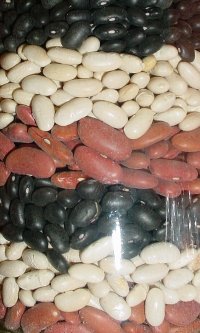
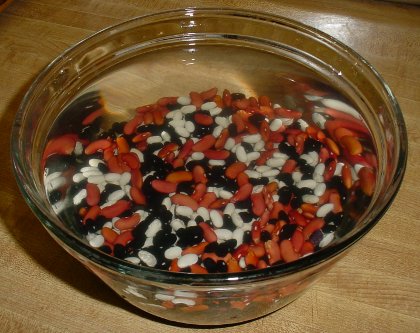
My sister was the first one to turn me
on to the idea of mixing the colors, "just because it looks good." I
buy the beans in bulk single variety bags, and mix them when I'm
organizing my stash. I like to leave the next batch mixed in a jar in
the closet for a week or two before I cook them. It does look good, and
I can change the look with each batch if I want to.
Basically, the recipe starts with "put
a pound or so of beans in the bowl." Rinse and swish until the water
runs clear. Then soak overnight and change the water. After that I add
spices and cook. Spices usually include salt and garlic. Sometimes I
add red peper. These are spices that do well having the bejezus boiled
out of them, because that's what cooking beans amounts to.
I usually cook mine in the microwave
oven. I add water until the bowl
is almost totally full, put a microwave safe plate on top of the batch,
and nuke it on high until it starts boiling. Then I cook it for 99
minutes and 99 seconds (the most my timer will allow) at a third of
full power, my machine's version
of simmer. (Your milage may vary.) At this point the best thing to do
is walk away for a couple
of hours. What you want is for all of the heat to go into making the
beans into a soft mush. Opening the door and taking off the lid to
examine them just lets out heat. You can see if they're getting too dry
through the microwave door because that's when the water level is below
the top of the beans. If that happens open it to add water. It only
happens if it boils over before you turn down the heat once you get
your recipe right.
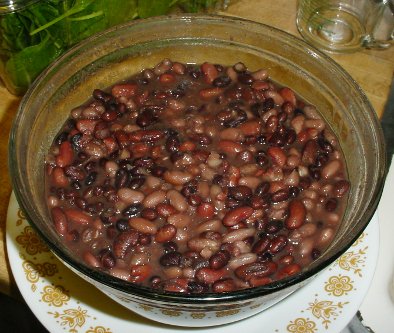
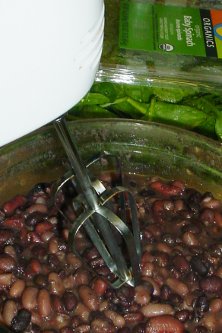
Once the beans are cooked, they taste
great and have the texture of soft shelled pills of mashed potatoes.
Just like that they are great for putting in burritos and serving as a
side dish. If you want to make bean dip you need to beat them WHILE
THEY ARE STILL HOT. To do that, get out the mixer and beat them like a
cake mix.
Believe it or not, adding the onions
gives the final product a sweet quality. To do this start by chopping
the onions into a skillet on the stove with a bit of olive oil in it.
Turn on the heat when you put the first onions in the pan. I find that
one half pound onion is usually about right. I use the high end of
medium heat.
I leave it covered when I'm not
stirring. I like to wait until I can see that lots of water has
collected on the bottom of the lid to open it and stir again. When I
take off the lid I shake the condensation into the sink to speed up the
dewaterization a bit. Laura Stek explained to me that the carmelization
occurs at a temperature of about 350 degrees, and water keeps it down
to 212 degrees. I just stir and let it cook down some more and then
repeat.
When the onions are done I stir them
into the beans. I taste the
resulting goop and adjust the seasoning as required. Then I decant most
of the the mixture into jars and put them in the fridge. I've found
that if I do this while it's still hot the jars sort of seal, and they
do fine in the fridge for a week or two at least. I eat the rest hot,
making it part of the meal I was looking forward to while cooking.
2111
I would love to hear any
suggestions you may have on how to make this recipe
better.




